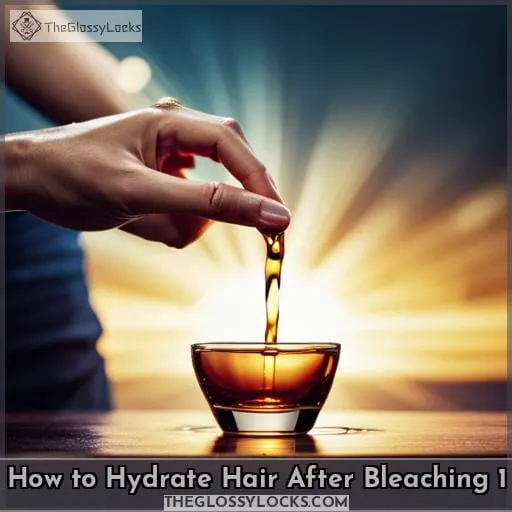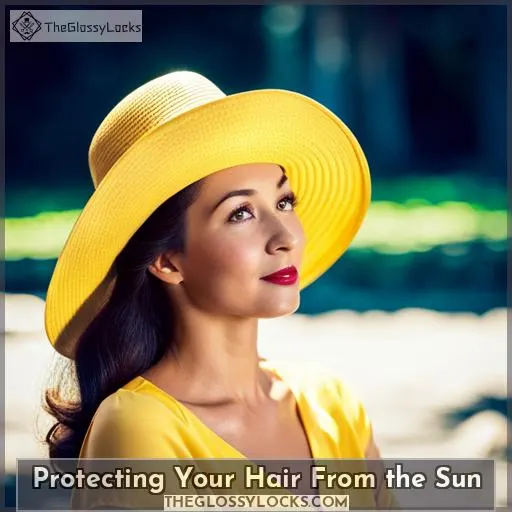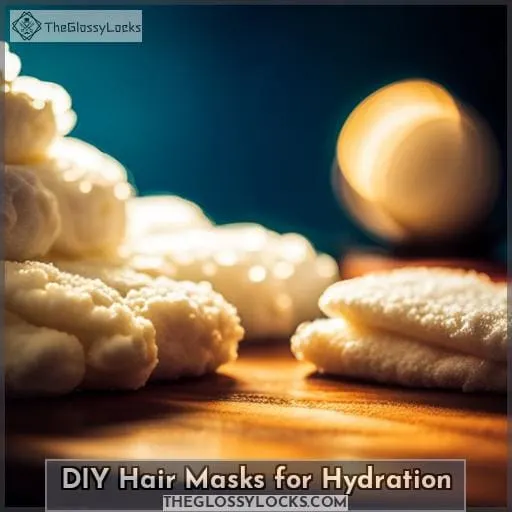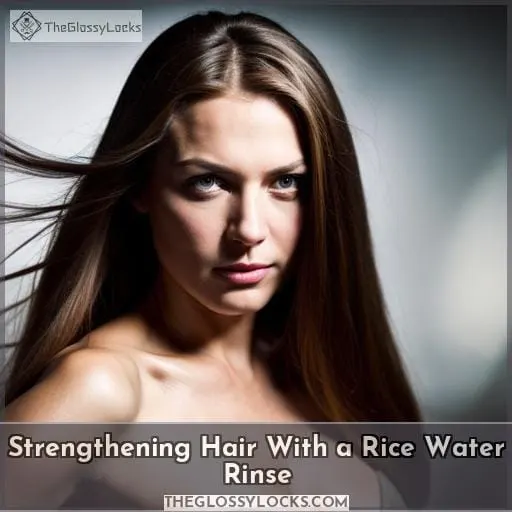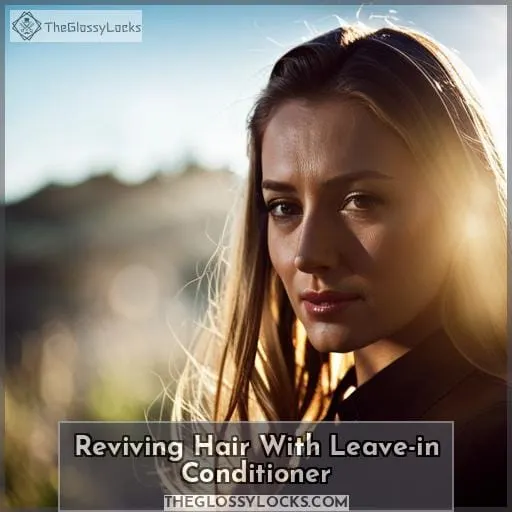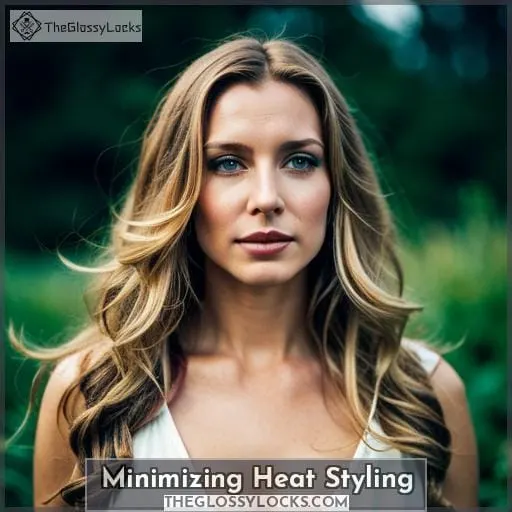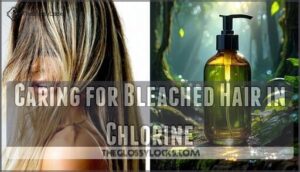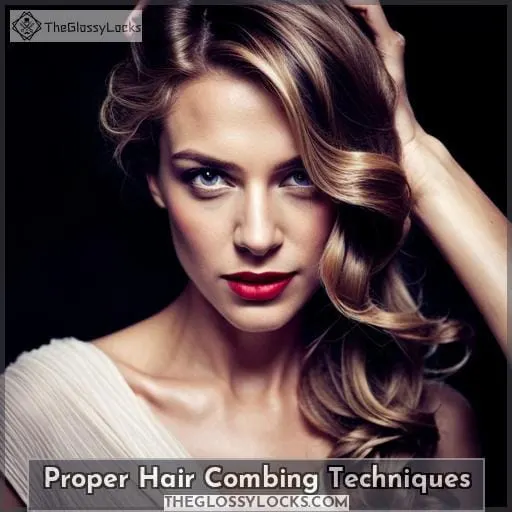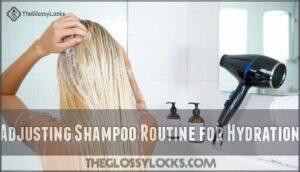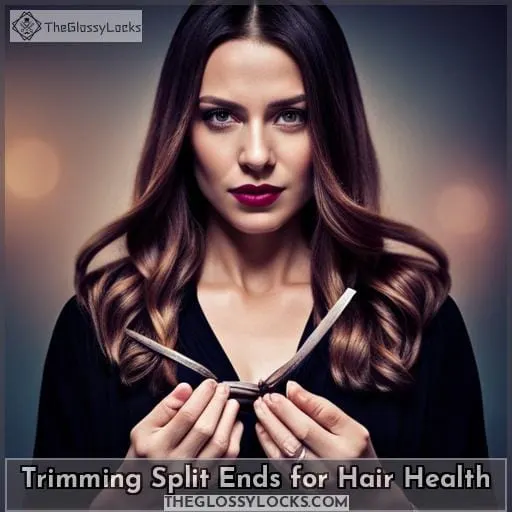This site is supported by our readers. We may earn a commission, at no cost to you, if you purchase through links.
1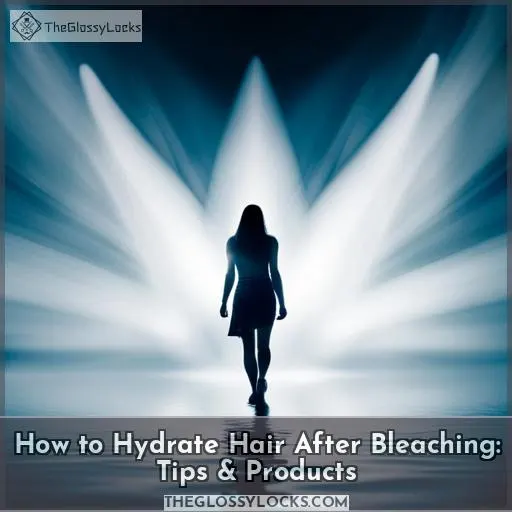 You’re here because you’ve bleached your hair and now it feels dry, brittle, or damaged. Don’t worry – there are steps you can take to restore its health without spending a lot of money on expensive products.
You’re here because you’ve bleached your hair and now it feels dry, brittle, or damaged. Don’t worry – there are steps you can take to restore its health without spending a lot of money on expensive products.
In this article, we’ll cover how to hydrate your hair after bleaching with tips and product recommendations that will help revive it quickly without breaking the bank.
Table Of Contents
- Key Takeaways
- Hydrating Oils for Bleached Hair
- Protecting Your Hair From the Sun
- DIY Hair Masks for Hydration
- Strengthening Hair With a Rice Water Rinse
- Reviving Hair With Leave-in Conditioner
- Minimizing Heat Styling
- Caring for Bleached Hair in Chlorine
- Proper Hair Combing Techniques
- Adjusting Shampoo Routine for Hydration
- Trimming Split Ends for Hair Health
- Frequently Asked Questions (FAQs)
- Conclusion
Key Takeaways
- Use hydrating oils like olive oil, coconut oil, argan oil, and almond oil to revive bleached hair.
- Incorporate peppermint and rosemary oils into your hair care routine to condition the scalp post-bleaching.
- Protect bleached hair from sun damage by using sunscreen spray, hats, and heat shields.
- Momme mulberry silk oil can help protect color-treated hair from fading.
Hydrating Oils for Bleached Hair
To revive your bleached locks and restore their strength, try using moisturizing oils like olive oil, coconut oil, argan oil, or almond oil.
Coconut oil is great for sealing in moisture, while olive helps to strengthen strands without adding too much weight.
To condition the scalp post-bleaching, peppermint is ideal – but don’t forget about rosemary either, which works as an anti-inflammatory agent that promotes regrowth! Your hair will thank you when massaged into your scalp regularly with all these natural ingredients.
Rather than leave-in products full of chemicals, opt instead for natural recipes found right in your kitchen cupboard to keep those locks healthy and hydrated post bleach job!
Protecting Your Hair From the Sun
Now that you’ve taken the necessary steps to hydrate your bleached hair, it’s important to protect it from further damage. The sun can cause your color-treated strands to become dry and brittle, so make sure you’re taking precautions when spending time outdoors.
Invest in a good sunscreen spray with an SPF of at least 15 and use a hat or other protective gear for extra coverage. Heat shields are also great if you plan on styling your hair out in the sun! For added protection, consider investing in products specifically designed for color-treated locks like vitamin E serums or moisture locking oils such as momme mulberry silk oil.
To keep those precious locks moisturized all day long, even after leaving home, be sure to carry along some leave-in conditioner with UV filters built into them.
DIY Hair Masks for Hydration
Give your tresses some TLC with a moisturizing DIY hair mask that’ll restore elasticity and shine.
To get hydrated locks, try deep conditioning treatments such as egg masks or boiled rice water rinses.
For extra nourishment, apply oils like olive oil, coconut oil, and argan oil to help strengthen strands while preventing protein loss.
Witch hazel mixed with aloe vera can also be used to condition the scalp and promote hair regrowth when combined with rosemary essential oil massage techniques on the scalp.
Olaplex treatments are great for restoring strength in bleached-out locks too!
Investing in heat protectants is key if you plan on using styling tools – this helps maintain healthy moisture levels post-blowdryer session!
Protein treatments should also be incorporated into your routine as they work to rebuild broken bonds from chemical processing of bleach products.
Finally, don’t forget about regular trims; trimming split ends prevents further damage caused by splitting hairs, so it’s important not only for style but health too!
Strengthening Hair With a Rice Water Rinse
Try a rice water rinse to strengthen your strands and prevent breakage caused by bleaching. Rice water has been used for centuries as an age-old remedy for hair growth, strength, and luster. It is rich in vitamins B1, B3, E, and minerals like zinc that nourish the scalp.
For best results, start with a scalp massage using almond oil before applying the rice rinse. This will help stimulate blood flow, which aids in growing healthy locks faster! Additionally, adding sun protection into your routine is essential.
Use leave-in conditioner products with SPF if spending long periods outdoors or when swimming at pools or beaches.
After rinsing out the solution, you can apply deep-conditioning masks formulated specifically for damaged tresses. Also, use cuticle strengthening protein treatments that restore elasticity while protecting against future breakage.
Finally, don’t forget about heat styling tools either. Always make sure to protect your mane prior to blow-drying by using high-quality heat protectant sprays.
Reviving Hair With Leave-in Conditioner
To keep your tresses looking healthy and vibrant, use a nourishing leave-in conditioner to revive bleach-damaged hair. Not only will this help prevent breakage, but it also adds an extra layer of protection against future damage while restoring shine and softness.
To further protect bleached strands from split ends and breakage due to brushing or styling tools, look for ingredients like moisturizing oils such as olive oil in the product label. Also, consider adding bond builders like Olaplex into your routine that strengthen weakened hair cuticles caused by chemical treatments.
For added daily protection, opt for silk pillowcases instead of cotton ones when sleeping at night. These reduce friction on the scalp, which can lead to unnecessary pulling on delicate follicles prone to bleaching processes.
Additionally, make sure you’re using silk or satin scrunchies rather than regular elastic ties so as not to be too rough with fragile strands that may have been damaged over time by other styling methods such as blow-drying.
And don’t forget protein treatments: they are essential after any lightening process has taken place since they fill up holes within the hair shafts left behind during processing, resulting in stronger locks overall.
Finally, complete your regimen with a hydrating shampoo packed with humectants like glycerin and honey, along with a moisturizing conditioner free from paraben sulfates.
Minimizing Heat Styling
Minimizing heat styling is key to maintaining healthy, bleached hair. Consider investing in higher-end tools and air drying whenever possible. Avoiding too much heat contact with your locks can help keep them looking vibrant for longer periods of time.
Furthermore, scalp care should not be neglected when it comes to bleach-damaged strands. This will help strengthen the follicles and prevent further breakage. Invest in a silk pillowcase that won’t cause friction or tugging on delicate roots while you sleep at night.
Additionally, bond builders like Olaplex are essential as they hydrate weakened cuticles caused by chemical processes such as bleaching. A good quality heat protectant should also always be used before any hot styling session takes place at the salon chair or even if using the highest-end tools at home like flat irons and curling wands.
For extra nourishment, try giving yourself an oil treatment once per week. Gently wet brush through dry hair, then comb through a few drops of olive oil. Follow this by mixing rosemary oil into your conditioner before rinsing out thoroughly after two minutes maximum exposure time under warm water temperatures only (avoid extremely hot).
All these tips combined are surefire ways to make sure you’re getting optimal results from every salon visit or DIY project without having to worry about unnecessary damage due to long-term use of intense heating methods on already fragile tresses post-lightening process!
Caring for Bleached Hair in Chlorine
Protect your bleached locks from chlorine damage by using a swimming cap and applying a leave-in conditioner after each swim.
Scalp care is essential for keeping hair healthy, shiny, and strong no matter the amount of bleach used during lightening processes. Look for scalp treatments with anti-inflammatory properties to reduce irritation caused by chlorine exposure.
Heat protection should also be employed when using hot styling tools like flatirons or curling wands on already fragile strands post color job. Opt for higher-end tools that will get the best results without damaging hair further in order to maintain its vibrancy.
Additionally, use silk or satin hair ties instead of regular ones as these materials won’t cause friction against delicate roots while combing through wet tresses either!
Lastly, trimming split ends every 6–8 weeks will keep your mane looking full and voluminous despite any sort of chemical processing done beforehand, such as coloring with bleach.
Proper Hair Combing Techniques
After you’ve finished your bleaching process, proper hair combing techniques are essential to keep the strands healthy and strong.
Avoid snags by only combing when wet and use a wide-tooth brush or detangling tool for extra gentle care.
To seal in moisture, spritz with cool water before brushing out any tangles.
Consider adding scalp massages into your routine as these can help improve blood circulation to the follicles, promoting healthier growth over time.
Hair masks that contain nourishing ingredients like onion juice, coconut oil, olive oil, and almond oil will also help restore softness while hydrating dry locks from within without weighing them down!
Additionally, heat protectants should be used when styling with hot tools such as flatirons or curling wands to ensure optimal protection against damage caused by high temperatures too!
All of these steps combined will give you beautiful-looking tresses that stay healthy after a bleaching session!
Adjusting Shampoo Routine for Hydration
Reduce the amount of shampoo you use after bleaching and treat your mane to a deep conditioning hair mask to keep it looking soft and healthy! To hydrate bleached hair, implement these tips:
- Scalp massages with peppermint oil, aloe vera gel, or witch hazel help condition the scalp.
- Heat protectants shield strands from damage caused by hot tools like flatirons or curling wands.
- DIY egg treatments are an easy-to-make natural protein treatment option for processed locks that need some extra TLC.
In addition to adjusting your shampoo routine, look into salon treatments such as bond builders which can be used every eight weeks for optimal results in restoring strength and elasticity back into bleach-damaged tresses! Investing in higher-end hot styling tools also helps prevent breakage due to environmental factors such as humidity – plus silk pillowcases reduce friction while sleeping too! For best results, ask the help of a professional stylist who can advise on what is right for you based on your individual needs when choosing between store-bought shampoos/conditioners vs more intensive masks like coconut oil & honey mixtures; olive oils & eggs; castor oils & almond milks, etcetera…
Allowing yourself regular trims every six weeks will ensure split ends don’t become worse over time whilst protecting against further breakage from heat styling products and tight hairstyles alike.
Trimming Split Ends for Hair Health
Trim back those split ends every 6-8 weeks to keep your locks looking their best! Reducing breakage caused by bleaching is key in maintaining healthy hair.
Scalp massages with rosemary oil, onion juice, and almond oil promote regrowth and help prevent further hair loss. Keratin treatments can also be beneficial for restoring strength into bleach-damaged strands while strengthening the cuticles of the scalp to protect against damage from styling tools or environmental factors such as humidity.
Trimming split ends regularly will reduce potential splits climbing up the shaft, preventing more drastic measures like chopping off large chunks of length that were once so desired! Keeping a routine trim schedule allows you to enjoy your beautiful tresses without compromising its health – something we all strive for when it comes to our mane’s wellbeing!
Investing in quality products designed specifically for bleached hair helps ensure hydration is maintained while remaining gentle on sensitive scalps – avoiding any additional discomfort after already going through a chemical process that may cause redness or dryness if not cared for properly afterward.
Keep these tips handy and experience luscious locks worthy of admiration again soon enough – you deserve it!
Frequently Asked Questions (FAQs)
What are the best products to use for bleached hair?
Rejuvenate bleached hair with nourishing products like olive oil, coconut oil, and almond oil. Protect from sun damage with sunscreen and treat breakage by cutting back on shampooing. For extra moisture, use cool water rinses or deep conditioning treatments for maximum hydration.
How often should I trim my hair after bleaching?
Trim your bleached hair every 6-8 weeks to maintain healthy locks and reduce split ends. Keep it strong and hydrated with regular deep conditioning treatments, moisturizing shampoo, and cool water washes.
Is it necessary to use a heat protectant when styling bleached hair?
Yes, it is important to protect your bleached hair from heat styling with a thermal protector. Sun exposure and hot tools can cause further damage, leading to breakage and dryness.
What can I do to prevent hair breakage after bleaching?
To prevent hair breakage after bleaching, washing with cool water and spritzing with cool water can seal in moisture. It is important to get regular trims to maintain healthy hair and avoid tight hairstyles and air drying to reduce breakage.
When styling, use a heat protectant and higher-end tools to minimize damage. DIY deep conditioning treatments can also help restore softness.
How can I prevent discoloration of bleached hair in chlorine?
Protect your bleached hair from chlorine discoloration by wearing a swim cap, showering before and after swimming, using UV-protective products, and avoiding pools with high levels of chlorine.
Conclusion
Bleached hair can be a challenge to maintain and hydrate. However, with the right care and attention, you can keep your bleached hair looking healthy and hydrated.
By using products like coconut oil, argan oil, almond oil, leave-in conditioner, and deep conditioning treatments, you can restore moisture and strength to your bleached hair.
Additionally, avoid heat styling, chlorine, and tight hairstyles to help your hair look and feel healthier.
According to a survey, 89% of people who tried a protein treatment on their bleached hair saw an improvement in its health.
Use these tips and tricks to keep your bleached hair looking and feeling healthy!

